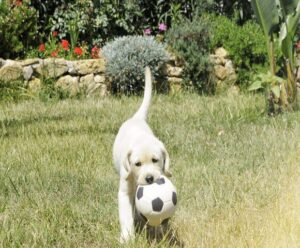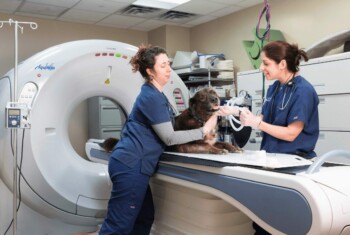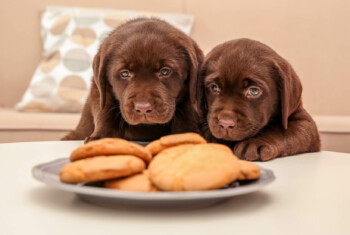How to make a pet-friendly garden.
Sunshine, fresh air and room to run make outside a fun place to be. But, while your dog plays, you want to be mindful of dangers looming in your garden. From certain types of flowers to the mulch and fertilizers you use to keep your lawn and garden healthy, it’s important to know what’s safe and what could be harmful to your pets.
“In a pet emergency room, it’s common to see dogs coming in because of something they ingested from their owner’s lawn or garden,” says Dr. John Gicking, a board-certified specialist in veterinary emergency and critical care at the BluePearl Pet Hospital in Tampa.
Cocoa mulch.
You may find it surprising to learn that one of the most common garden dangers for dogs is an aromatic variety of mulch. Cocoa mulch, known for its rich chocolate-brown color and nutritional benefits for soil, is toxic to canines. It contains cocoa bean shells and various chemicals that can make a dog sick if ingested, just as if he had eaten too much chocolate candy.
Unfortunately, the chocolate aroma appeals to many dogs, making cocoa mulch a huge threat in the gardens of pet families. Cocoa mulch ingestion can lead to:
- Gastrointestinal irritation
- Vomiting
- Diarrhea
- Rapid heart rate
- Muscle tremors
- Weakness
- Seizures
- Death
While cocoa mulch may look appealing, dog owners may choose a safer alternative such as dirt, stones or mulch made from shredded pine, cedar or hemlock bark.
Commercial and natural fertilizers.
Keeping your garden healthy and beautiful can be a lot of work. Many people turn to fertilizers to help feed their lawns and gardens. While they can work wonders for your plants, those fertilizers can spell trouble for your pup.
While commercial fertilizers may provide nutrition for plants, they contain harmful chemicals that are toxic to dogs. Your dog can accidentally consume these chemicals when they are sprinkled on the lawn or garden just by running and playing outside and then grooming himself.
While even small amounts can cause issues, you want to keep your pet away from fertilizers altogether. When a pet consumes larger amounts of fertilizer, like when they find the bag in storage, it can become a life-threatening situation.
“Be aware of when you apply fertilizers and pesticides and how you store them,” says Dr. Gicking. “The key is to minimize your pet’s exposure to them.”
Signs that your dog consumed fertilizer include:
- Drooling
- Nausea
- Vomiting
- Diarrhea
- Difficulty breathing
- Tremors and seizures
Organic fertilizers sound safe. But surprisingly, many of them are actually more dangerous. Organic or “natural” fertilizers often contain various “meal” leftovers from the farming or meat industries. These products, such as bone meal, blood meal, feather meal and fish meal, are attractive to dogs, but unhealthy for their digestive systems.
Signs and complications include:
- Vomiting
- Diarrhea
- Intestinal obstruction
- Severe pancreatitis (inflamed pancreas)
Plants and flowers.
Before you take a trip to your local gardening center, check out this video to learn which plants are toxic and which plants are safe for pets. Even some well-known and loved flowers can be harmful if ingested.
According to petMD, the following common plants are poisonous to pets:
Garden plants.
Lilies: Loved for their colorful varieties, lilies are extremely toxic to cats. Ingesting any part of the lily, even a few grains of pollen can cause your cat to develop fatal kidney failure.
- Daffodils: Sunny and star-shaped, daffodils provide a pleasant dose of sunny beauty to a front lawn. But these flowers are highly toxic to dogs. If ingested by a dog, symptoms such as vomiting, diarrhea, abdominal pain, convulsions and a drop in blood pressure may arise.
- Tulips: Tulips are one of the most common garden flowers, but they contain toxins that can make a dog ill. The bulb is the most harmful part. Symptoms of tulip ingestion in dogs include excessive drooling, nausea and irritation in the mouth.
- Azaleas: Usually boasting a bright pink hue, azaleas bring a pop of neon color to any garden. Though these flowers are pretty to look at, they can be fatal if ingested by your canine companion. Symptoms include digestive problems, such as vomiting and diarrhea, and low blood pressure.
- Autumn Crocus: The autumn crocus is known for pretty purple and fuchsia flowers that blossom in the spring. But this colorful member of the lily family causes a burning feeling in a dog’s mouth. Other symptoms include digestive distress, liver and kidney damage and heart complications. The highest levels of toxicity are found in the bulbs.
- Oleander: Oleander is a popular and colorful shrub typically found in warmer climates. It contains cardiac glycosides, which can be fatal to dogs. Signs that a dog has consumed oleander include muscle tremor, vomiting and bloody diarrhea.
- Amaryllis: The amaryllis flower is quite distinct because of its vibrant red color. It’s filled with toxins, however, that can induce vomiting in dogs. Other symptoms include depression, excessive drooling, anorexia and tremors.
- Sago Palm: While sago palm may look like a simple green, leafy plant, it’s actually highly toxic to dogs. This common plant, which grows outdoors or indoors, can cause bloody vomiting, bleeding disorders, diarrhea, liver failure and death.
Mushrooms.
You’re probably not growing any mushrooms in your lawn or garden intentionally, but every once in a while, they still pop up. While many are harmless, some mushrooms can be dangerous or even deadly if consumed by your pets. For many homeowners, it can be very difficult to distinguish the harmless from the dangerous.
The Amanita family of mushrooms is one of the more commonly found, but harmful mushrooms. This family includes the “death cap” and gives off a fishy odor, making them tempting to dogs. Other dangerous mushrooms include the Lepiota and Galerina families.
Dr. Gicking says that the best method is simply to play it safe. “If you see mushrooms growing in your yard or garden, you want to remove them.”
 Keep in mind.
Keep in mind.
Always actively supervise your dogs when they are outdoors. If your pet ingests a harmful toxin in the garden, seek immediate emergency veterinary care. If you know that they ate something harmful, bring a sample of the substance with you.
It’s great to get outside with your dog. The fresh air and exercise are good for both you and them. If you want to keep your pup happy and safe, create a lawn and garden that’s as pet-friendly as it is beautiful.
For questions about outdoor pet safety, please contact your family veterinarian or a BluePearl Pet Hospital near you.



